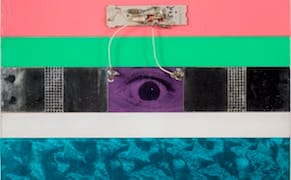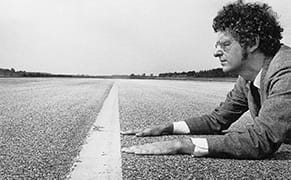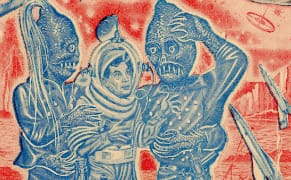
Art
Robert Smithson's Sacred and Profane Pop
Pop, an exhibition currently on view at James Cohan’s new Grand Street location, explores a more obscure phase of Robert Smithson’s tragically brief career: his figurative engagement with popular culture.

Art
Pop, an exhibition currently on view at James Cohan’s new Grand Street location, explores a more obscure phase of Robert Smithson’s tragically brief career: his figurative engagement with popular culture.

Interview
In his new documentary, Troublemakers: The Story of Land Art, filmmaker and art historian James Crump digs beneath the surface to explore the personal lives, artworks, and historical treatment of three land artists: Michael Heizer, Walter De Maria, and Robert Smithson.

Art
At Dia:Beacon there is an installation by Fred Sandback, a series of giant shapes formed from brightly colored string.

Art
Space exploration and the science fiction imagination of alien encounters out in the stars reached their peak of optimistic possibility between the 1940s and 1970s, culminating with the first moon landing in 1969.

Art
On July 20, 1969, the world watched, and was transfixed, as American astronaut Neil Armstrong — rendered on television as a ghostly black-and-white figure — descended from the Lunar Module onto the surface of the moon.

Art
ROZEL POINT, Utah — Beginning with childhood visits to the American Museum of Natural History and continuing with excursions to study rock formations throughout his adult life, Robert Smithson cultivated a lifelong obsession with natural (and human) history that explicitly informed his artwork, incl

Art
The inaugural exhibition at the new Whitney Museum is not perfect, but it is pretty damn good.

Art
PARIS — The use of mirrors in art has been a rich one, used by Pop, Kinetic, Minimal, and Conceptual artists. In this long tradition, the Jeu de Paume currently offers an additional point of reference.

Opinion
Earlier today @museumnerd tweeted out a link to a view of Michael Heizer's land work "Double Negative" (1969) in Google Maps. Viewed in satellite, from high above, Heizer's 1,500-foot-long trenches looks almost incidental, like cuts made with scissors into the skin of the earth.

Art
Michael Heizer’s "Double Negative" (1969), located two hours northeast of Las Vegas, is a quintessential piece of the Land Art canon. Yet if you don’t have a clear image of what you’re looking for, you may not find it — this is no "Spiral Jetty."

Art
LONDON — Land art is having a moment in the UK. It was building last year with two shows, in Margate and Birmingham, by perambulatory artist Hamish Fulton. More ‘walking art’ is afoot in Sunderland. April found Nancy Holt on show in Manchester. And in maritime city Southampton, we have not one but t

Art
“What’s Wrong With Technological Art?” was the vexing question posed by the tony New Museum panel assembled by Megan Heuer featuring Heather Corcoran, the new executive director of Rhizome, and art historians Judith Rodenbeck, and Gloria Sutton. The event indadvertedly dove tailed with the recent Se